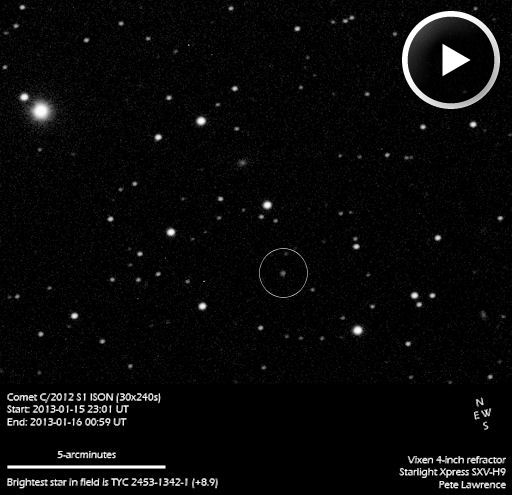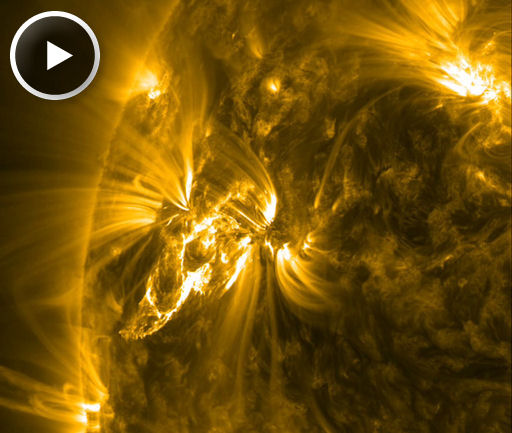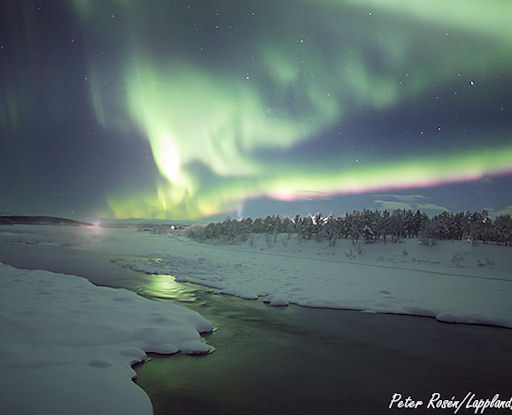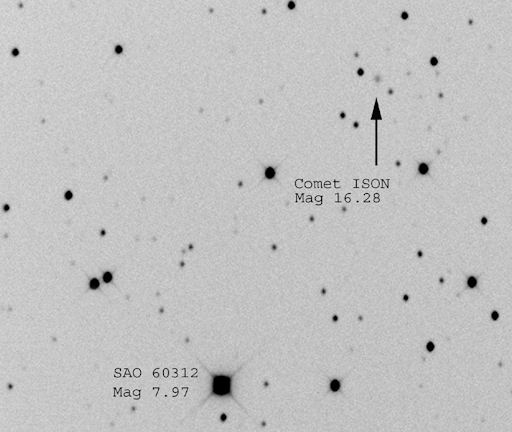UPDATE:
 |
 |
 |
|||||
| ||||||||||||||||||||||||||||||||||||||||||||||||||||||||||||||||||||||||||||
Correction: Sunspot Number Incorrect. Spotted by Knowledge Contribution Partner. |
| more links... |
ARCTIC AURORAS: A stream of solar wind is blowing around Earth and buffeting our planet's magnetic field. Although the pressure of the wind has not been strong enough to trigger a full-fledged geomagnetic storm, auroras are nevertheless dancing around the Arctic Circle. Peter Rosén sends this picture from Kiruna in the Swedish Lapland:
"Blue jeans, 1 meter of soft
snow, and a temperature of -15 degrees is usually
not a good combination," says Rosen. "But
who cares when the aurora dances above your head
like they did last night (Jan. 13th). The lights
kept me warm the entire night. It was the most powerfull
aurora so far for me this winter."
More auroras are in the offing. NOAA
forecasters estimate a 15% chance of polar geomagnetic
activity as the solar wind continues to blow.
Aurora alerts: text,
voice.
ACTIVE SUNSPOT: Big sunspot AR1654 is crackling with C- and M-class solar flares, and it poses a threat for even stronger eruptions. NOAA forecasters estimate a 10% chance of X-flares today. Solar flare alerts: text, voice.
Flares are illuminating the sunspot's
magnetic canopy like flash bulbs at a rock concert;
the phenomenon is evident in this 37-hour extreme
ultraviolet movie from NASA's Solar Dynamics Observatory:
Since it first appeared four days
ago, sunspot AR1654 has been facing away from Earth.
But now it is turning toward us, increasing the
"geo-effectiveness" of its explosions.
This could be the sunspot that breaks the recent
lengthy spell of calm space weather around our planet.
Amateur astronomers with backyard
solar telescopes are encouraged to monitor in the
days ahead. It is not only crackling, but also growing.
As of Jan 12th, the behemoth stretches more than
180,000 km (14 Earth diameters) from end to end.
Dennis Simmons sends this picture of the behemoth
from Brisbane, Australia:
"Although the air was milky
from nearby bush fires burning north of Brisbane,
the seeing turned out to be good enough for a high-resolution
shot," says Simmons. "I dedicate this
image to the brave Australian fire fighters, working
in horrendous, hot and windy conditions whilst fighting
fires burning out of control across the south-east
states of our country. I salute your selfless courage."
COMET ISON APPROACHES: Later this year, Comet ISON could put on an unforgettable display as it plunges toward the sun for a fiery encounter likely to turn the "dirty snowball" into a naked-eye object in broad daylight. At the moment, however, it doesn't look like much. John Chumack sends this picture, taken Jan. 8th, from his private observatory in Yellow Springs, Ohio:
"Comet ISON (C/2012 S1) is currently
in the constellation Gemini, moving between the
heads of the twins Castor and Pollux," says
Chumack. "It is still pretty faint, near 16th
magnitude, but don't be fooled by that. This could
become one of the best comets in many years."
Comet ISON is a sungrazer. On Nov.
28, 2013, it will fly through the sun's outer atmosphere
only 1.2 million km from the stellar surface below.
If the comet survives the encounter, it could emerge
glowing as brightly as the Moon, visible near the
sun in the blue daylight sky. The comet's dusty
tail stretching into the night would create a worldwide
sensation.
Comet ISON looks so puny now because
it is so far away, currently near the orbit of Jupiter.
As it falls toward the sun in the months ahead it
will warm up and reveal more about its true character.
By the summer of 2013, researchers should know whether
optimistic predictions about Comet ISON are justified.
Possibilities range from "Comet
of the Century" to disintegrated
dud. Stay tuned!
| Near Earth Asteroids |
On
January 14, 2013 there were 1368
potentially hazardous asteroids.
Recent
& Upcoming Earth-asteroid encounters:
| Asteroid |
Date(UT)
|
Miss
Distance
|
Size
|
| 2013 AG69 |
Jan 10
|
1.8 LD
|
15 m
|
| 2013 AF53 |
Jan 10
|
7.5 LD
|
21 m
|
| 2013 AB65 |
Jan 11
|
1.6 LD
|
13 m
|
| 2013 AB4 |
Jan 11
|
6.5 LD
|
15 m
|
| 1999 HA2 |
Feb 5
|
58 LD
|
1.3 km
|
| 3752 Camillo |
Feb 12
|
57.5 LD
|
3.4 km
|
| 1999 YK5 |
Feb 15
|
49.1 LD
|
2.1 km
|
| 2012 DA14 |
Feb 15
|
0.09 LD
|
58 m
|
| 2009 AV |
Feb 25
|
59.7 LD
|
1.0 km
|
| 2007 EO88 |
Mar 18
|
4.4 LD
|
23 m
|
| 1993 UC |
Mar 20
|
49 LD
|
3.8 km
|
| 1997 AP10 |
Mar 28
|
45.9 LD
|
1.8 km
|
| 2010 GM23 |
Apr 13
|
3.9 LD
|
50 m
|
| Essential web links |
| NOAA Space Weather Prediction Center |
| The official U.S. government space weather bureau |
| Atmospheric Optics |
| The first place to look for information about sundogs, pillars, rainbows and related phenomena. |
| Solar Dynamics Observatory |
| Researchers call it a "Hubble for the sun." SDO is the most advanced solar observatory ever. |
| STEREO |
| 3D views of the sun from NASA's Solar and Terrestrial Relations Observatory |
| Solar and Heliospheric Observatory |
| Realtime and archival images of the Sun from SOHO. |
| Daily Sunspot Summaries |
| from the NOAA Space Environment Center |
| Heliophysics |
| the underlying science of space weather |
| ] |
Situational Preparedness Update: Wednesdays 5P CST blogtalkradion/USAEBN Situational Preparedness Radio Show Update:Wednesdays 5P CST on blogtalkradion/USAEBN |
.JPG) |
| #10 CAN QuickStove Emergency Camp Stove Kit w/5 Firedisks - NebShip Shop |



























http://www.shakeout.org/
ReplyDelete